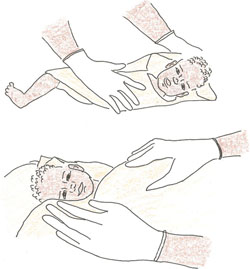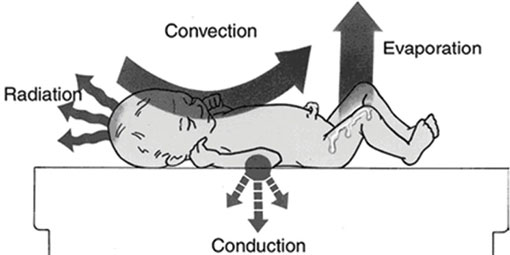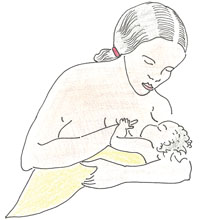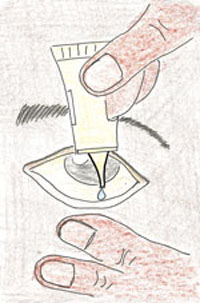The eight steps of essential newborn care
Before you look at the eight steps of essential newborn care (ENC) you need to remember the importance of the ‘three cleans’ that you learned in Study Session 3 of the Labour and Delivery Care Module. These are clean hands, clean surface and clean equipment. Your equipment should include two clean dry towels, cord clamps, razor blade, cord tie, functional resuscitation equipment, vitamin K, syringe and needles, and tetracycline eye ointment.

Step 1 Deliver the baby onto the mother’s abdomen or a dry warm surface close to the mother.
Continue to support and reassure the mother. Tell her the sex of the baby and congratulate her.
Step 2 Dry the baby’s body with a dry warm towel as you try to stimulate breathing. Wrap the baby with another dry warm cloth and cover the head (Figure 2.1).
Dry the baby well, including the head, immediately and then discard the wet cloth. Wipe the baby’s eyes. Rub up and down the baby’s back, using a clean, warm cloth. Drying often provides sufficient stimulation for breathing to start in mildly depressed newborn babies. Do your best not to remove the vernix (the creamy, white substance which may be on the skin) as it protects the skin and may help prevent infection. Then wrap the baby with another dry cloth and cover the head.
Step 3 Assess breathing and colour; if not breathing, gasping or there are less than 30 breaths per minute, then resuscitate.
You will remember that you learned how to manage a newborn baby with birth asphyxia in Study Session 7 of the Labour and Delivery Care Module.
As you dry the baby, assess its breathing. If a baby is breathing normally, both sides of the chest will rise and fall equally at around 30–60 times per minute. Thus, check if the baby is:
- Breathing normally
- Having trouble breathing
- Breathing less than 30 breaths per minute, or
- Not breathing at all.
If the baby needs resuscitation, quickly clamp or tie and cut the cord, leaving a stump at least 10 cm long for now and then start resuscitation immediately. Functional resuscitation equipment should always be ready and close to the delivery area since you must start resuscitation within one minute of birth. It may sound as if you have a lot to do in one minute, but the steps described here are ones that you can take simultaneously. That is, while you are delivering the baby onto the mother’s abdomen and drying the baby, you can assess breathing and colour and take urgent action if necessary.

Step 4 Tie the cord two fingers’ length from the baby’s abdomen and make another tie two fingers from the first one (Figure 2.2). Cut the cord between the first and second tie. If the baby needs resuscitation, cut the cord immediately. If not, wait for 7–3 minutes before cutting the cord.
- Tie the cord securely in two places:
- Tie the first one two fingers away from the baby’s abdomen.
- Tie the second one four fingers away from the baby’s abdomen.
- Make sure that tie is well secured; the thread you use to tie the cord must be clean.
- Cut the cord between the ties:
- Use a new razor blade, or a boiled one if it has been used before, or sterile scissors.
- Use a small piece of cloth or gauze to cover the part of the cord you are cutting so no blood splashes on you or on others.
- Be careful not to cut or injure the baby. Either cut away from the baby or place your hand between the cutting instrument and the baby.
- Do not put anything on the cord stump.
Step 5 Place the baby in skin-to-skin contact with the mother, cover with a warm cloth and initiate breastfeeding.
The newborn loses heat in four ways (see Figure 2.3 below):
- Evaporation: when amniotic fluid evaporates from the skin.
- Conduction: when the baby is placed naked on a cooler surface, such as the floor, table, weighing scales, cold bed.
- Convection: when the baby is exposed to cool surrounding air or to a draught from open doors and windows or a fan.
- Radiation: when the baby is near cool objects, walls, tables, cabinets, without actually being in contact with them.

The warmth of the mother passes easily to the baby and helps stabilise the baby’s temperature.
- Put the baby on the mother’s chest, between the breasts, for skin-to-skin warmth.
- Cover both mother and baby together with a warm cloth or blanket.
- Cover the baby’s head.
The first skin-to-skin contact should last uninterrupted for at least one hour after birth or until after the first breastfeed. The baby should not be bathed at birth because a bath can cool the baby dangerously. After 24 hours, the baby can have the first sponge bath, if the temperature is stabilised.

If everything is normal, the mother should immediately start breastfeeding.
For optimal breastfeeding you should do the following:
- Help the mother begin breastfeeding within the first hour of birth (Figure 2.4).
- Help the mother at the first feed. Make sure the baby has a good position, attachment, and is sucking well. Do not limit the length of time the baby feeds; early and unlimited breastfeeding gives the newborn energy to stay warm, nutrition to grow, and antibodies to fight infection.
The steps to keep the newborn warm are called the warm chain.
- Warm the delivery room.
- Immediate drying.
- Skin-to-skin contact at birth.
- Breastfeeding.
- Bathing and weighing postponed.
- Appropriate clothing/bedding.
- Mother and baby together.
- Warm transportation for a baby that needs referral.
Step 6 Give eye care (while the baby is held by its mother).

Shortly after breastfeeding and within one hour of being born, give the newborn eye care with an antimicrobial medication. Eye care protects the baby from serious eye infection which can result in blindness or even death.
The steps for giving the baby eye care are these:
First, wash your hands, and then using tetracycline 1% eye ointment:
- Hold one eye open and apply a rice grain size of ointment along the inside of the lower eyelid. Make sure not to let the medicine dropper or tube touch the baby’s eye or anything else (see Figure 2.5).
- Repeat this step to put medication into the other eye.
- Do not rinse out the eye medication.
- Wash your hands again.
Step 7 Give the baby vitamin K, 1 mg by intramuscular injection (IM) on the outside of the upper thigh (while the baby is held by its mother).
After following correct infection prevention steps, with the other hand stretch the skin on either side of the injection site and place the needle straight into the outside of the baby’s upper thigh (perpendicular to the skin). Then press the plunger to inject the medicine. You will be learning more about safe injection techniques in your practical skills training sessions. There is also a study session on routes of injection in the Immunization Module.
Step 8 Weigh the baby.
Weigh the baby an hour after birth or after the first breastfeed. If the baby weighs less than 1,500 gm you must refer the mother and baby urgently.
Why do you need to give essential newborn care?
At birth the newborn must adapt quickly to life outside the uterus. As a trained Health Extension Practitioner, you can take steps to ensure the baby is breathing well, kept warm and receives breastmilk from the mother.